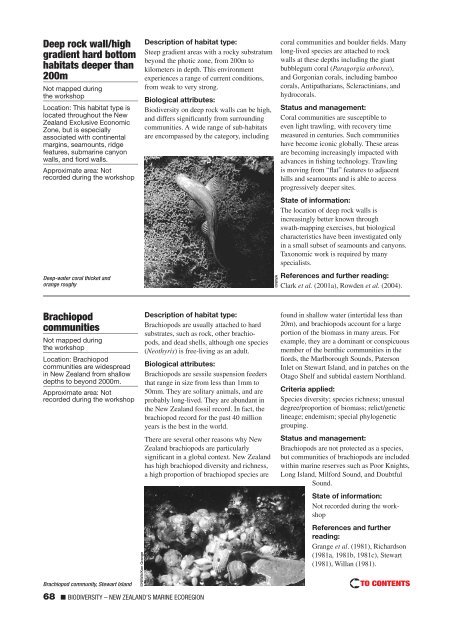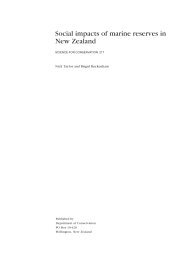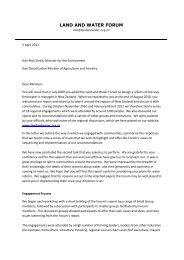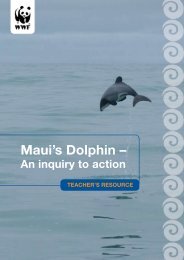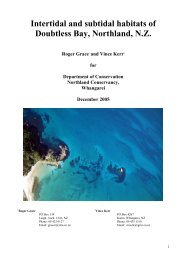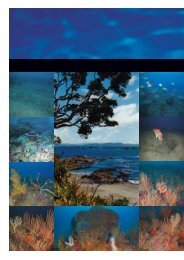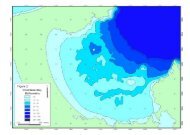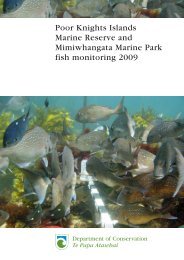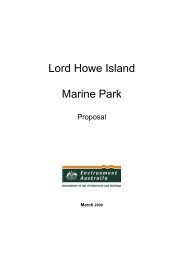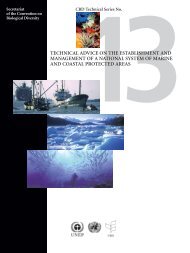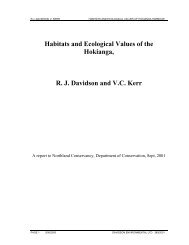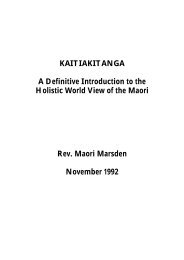WWF Shining a spotlight on the biodiversity of ... - MarineNZ.org.nz
WWF Shining a spotlight on the biodiversity of ... - MarineNZ.org.nz
WWF Shining a spotlight on the biodiversity of ... - MarineNZ.org.nz
Create successful ePaper yourself
Turn your PDF publications into a flip-book with our unique Google optimized e-Paper software.
Deep rock wall/high<br />
gradient hard bottom<br />
habitats deeper than<br />
200m<br />
Not mapped during<br />
<strong>the</strong> workshop<br />
Locati<strong>on</strong>: This habitat type is<br />
located throughout <strong>the</strong> New<br />
Zealand Exclusive Ec<strong>on</strong>omic<br />
Z<strong>on</strong>e, but is especially<br />
associated with c<strong>on</strong>tinental<br />
margins, seamounts, ridge<br />
features, submarine cany<strong>on</strong><br />
walls, and fiord walls.<br />
Approximate area: Not<br />
recorded during <strong>the</strong> workshop<br />
Deep-water coral thicket and<br />
orange roughy<br />
Descripti<strong>on</strong> <strong>of</strong> habitat type:<br />
Steep gradient areas with a rocky substratum<br />
bey<strong>on</strong>d <strong>the</strong> photic z<strong>on</strong>e, from 200m to<br />
kilometers in depth. This envir<strong>on</strong>ment<br />
experiences a range <strong>of</strong> current c<strong>on</strong>diti<strong>on</strong>s,<br />
from weak to very str<strong>on</strong>g.<br />
Biological attributes:<br />
Biodiversity <strong>on</strong> deep rock walls can be high,<br />
and differs significantly from surrounding<br />
communities. A wide range <strong>of</strong> sub-habitats<br />
are encompassed by <strong>the</strong> category, including<br />
©NIWA<br />
coral communities and boulder fields. Many<br />
l<strong>on</strong>g-lived species are attached to rock<br />
walls at <strong>the</strong>se depths including <strong>the</strong> giant<br />
bubblegum coral (Parag<strong>org</strong>ia arborea),<br />
and G<strong>org</strong><strong>on</strong>ian corals, including bamboo<br />
corals, Antipatharians, Scleractinians, and<br />
hydrocorals.<br />
Status and management:<br />
Coral communities are susceptible to<br />
even light trawling, with recovery time<br />
measured in centuries. Such communities<br />
have become ic<strong>on</strong>ic globally. These areas<br />
are becoming increasingly impacted with<br />
advances in fishing technology. Trawling<br />
is moving from “flat” features to adjacent<br />
hills and seamounts and is able to access<br />
progressively deeper sites.<br />
State <strong>of</strong> informati<strong>on</strong>:<br />
The locati<strong>on</strong> <strong>of</strong> deep rock walls is<br />
increasingly better known through<br />
swath-mapping exercises, but biological<br />
characteristics have been investigated <strong>on</strong>ly<br />
in a small subset <strong>of</strong> seamounts and cany<strong>on</strong>s.<br />
Tax<strong>on</strong>omic work is required by many<br />
specialists.<br />
References and fur<strong>the</strong>r reading:<br />
Clark et al. (2001a), Rowden et al. (2004).<br />
Brachiopod<br />
communities<br />
Not mapped during<br />
<strong>the</strong> workshop<br />
Locati<strong>on</strong>: Brachiopod<br />
communities are widespread<br />
in New Zealand from shallow<br />
depths to bey<strong>on</strong>d 2000m.<br />
Approximate area: Not<br />
recorded during <strong>the</strong> workshop<br />
Brachiopod community, Stewart Island<br />
©NIWA/Ken Grange<br />
Descripti<strong>on</strong> <strong>of</strong> habitat type:<br />
Brachiopods are usually attached to hard<br />
substrates, such as rock, o<strong>the</strong>r brachiopods,<br />
and dead shells, although <strong>on</strong>e species<br />
(Neothyris) is free-living as an adult.<br />
Biological attributes:<br />
Brachiopods are sessile suspensi<strong>on</strong> feeders<br />
that range in size from less than 1mm to<br />
50mm. They are solitary animals, and are<br />
probably l<strong>on</strong>g-lived. They are abundant in<br />
<strong>the</strong> New Zealand fossil record. In fact, <strong>the</strong><br />
brachiopod record for <strong>the</strong> past 40 milli<strong>on</strong><br />
years is <strong>the</strong> best in <strong>the</strong> world.<br />
There are several o<strong>the</strong>r reas<strong>on</strong>s why New<br />
Zealand brachiopods are particularly<br />
significant in a global c<strong>on</strong>text. New Zealand<br />
has high brachiopod diversity and richness,<br />
a high proporti<strong>on</strong> <strong>of</strong> brachiopod species are<br />
found in shallow water (intertidal less than<br />
20m), and brachiopods account for a large<br />
porti<strong>on</strong> <strong>of</strong> <strong>the</strong> biomass in many areas. For<br />
example, <strong>the</strong>y are a dominant or c<strong>on</strong>spicuous<br />
member <strong>of</strong> <strong>the</strong> benthic communities in <strong>the</strong><br />
fiords, <strong>the</strong> Marlborough Sounds, Paters<strong>on</strong><br />
Inlet <strong>on</strong> Stewart Island, and in patches <strong>on</strong> <strong>the</strong><br />
Otago Shelf and subtidal eastern Northland.<br />
Criteria applied:<br />
Species diversity; species richness; unusual<br />
degree/proporti<strong>on</strong> <strong>of</strong> biomass; relict/genetic<br />
lineage; endemism; special phylogenetic<br />
grouping.<br />
Status and management:<br />
Brachiopods are not protected as a species,<br />
but communities <strong>of</strong> brachiopods are included<br />
within marine reserves such as Poor Knights,<br />
L<strong>on</strong>g Island, Milford Sound, and Doubtful<br />
Sound.<br />
State <strong>of</strong> informati<strong>on</strong>:<br />
Not recorded during <strong>the</strong> workshop<br />
References and fur<strong>the</strong>r<br />
reading:<br />
Grange et al. (1981), Richards<strong>on</strong><br />
(1981a, 1981b, 1981c), Stewart<br />
(1981), Willan (1981).<br />
68 ■ BIODIVERSITY – NEW ZEALAND’S MARINE ECOREGION


